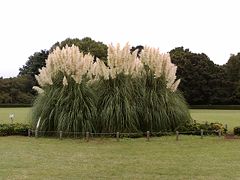
Jindai Botanical Garden
Encyclopedia


Musashino
Musashino may refer to:* Musashino , a train service in Japan* Musashino, Tokyo, a city in Greater Tokyo, Japan* Musashino Line, a railway line in Greater Tokyo, Japan* 3249 Musashino, an asteroid* Musashino Terrace...
plateau just above Jindaiji Temple in Chōfu, Tokyo
Chofu, Tokyo
is a city located in the western end of Tokyo Metropolis, Japan. As of 2010, the city has an estimated population of 224,878 and a population density of 10,440 persons per km². The total area was 21.53 km². Tokyo Stadium in Chōfu hosts soccer games for two J. League teams: F.C...
, Japan
Japan
Japan is an island nation in East Asia. Located in the Pacific Ocean, it lies to the east of the Sea of Japan, China, North Korea, South Korea and Russia, stretching from the Sea of Okhotsk in the north to the East China Sea and Taiwan in the south...
. It extends across 425,433 square meters, and each of its thirty areas features varieties of one kind of plant. Displays of ume
Ume
Prunus mume, with the common names including Chinese plum and Japanese apricot, is an Asian tree species classified in the Armeniaca section of the genus Prunus. The flower, long a beloved subject in the traditional painting of East Asia, is usually translated as plum blossom. This distinct tree...
, cherries
Sakura
A cherry blossom is the flower of any of several trees of genus Prunus, particularly the Japanese Cherry, Prunus serrulata, which is sometimes called sakura after the Japanese . Many of the varieties that have been cultivated for ornamental use do not produce fruit...
, azalea
Azalea
Azaleas are flowering shrubs comprising two of the eight subgenera of the genus Rhododendron, Pentanthera and Tsutsuji . Azaleas bloom in spring, their flowers often lasting several weeks...
, dogwood
Dogwood
The genus Cornus is a group of about 30-60 species of woody plants in the family Cornaceae, commonly known as dogwoods. Most dogwoods are deciduous trees or shrubs, but a few species are nearly herbaceous perennial subshrubs, and a few of the woody species are evergreen...
, peonies
Peony
Peony or paeony is a name for plants in the genus Paeonia, the only genus in the flowering plant family Paeoniaceae. They are native to Asia, southern Europe and western North America...
, rose
Rose
A rose is a woody perennial of the genus Rosa, within the family Rosaceae. There are over 100 species. They form a group of erect shrubs, and climbing or trailing plants, with stems that are often armed with sharp prickles. Flowers are large and showy, in colours ranging from white through yellows...
s, wisteria
Wisteria
Wisteria is a genus of flowering plants in the pea family, Fabaceae, that includes ten species of woody climbing vines native to the eastern United States and to China, Korea, and Japan. Aquarists refer to the species Hygrophila difformis, in the family Acanthaceae, as Water Wisteria...
or other can be seen every month. In front of the temple below there is also a wetland
Wetland
A wetland is an area of land whose soil is saturated with water either permanently or seasonally. Wetlands are categorised by their characteristic vegetation, which is adapted to these unique soil conditions....
annex for aquatic plants, where irises
Iris (plant)
Iris is a genus of 260-300species of flowering plants with showy flowers. It takes its name from the Greek word for a rainbow, referring to the wide variety of flower colors found among the many species...
are cultivated.
The garden has 100,000 trees and shrubs representing approximately 4,500 varieties, each with an identifying label. The park has a plant protection program to preserve endangered Japanese species and exhibitions and activities related to gardening for the benefit of local citizens. Just outside the rear gate there is an area where some plants are sold.
The site of Jindai Botanical Garden was once part of a medieval fortress said to date from 1537. Later it was a nursery
Nursery (horticulture)
A nursery is a place where plants are propagated and grown to usable size. They include retail nurseries which sell to the general public, wholesale nurseries which sell only to businesses such as other nurseries and to commercial gardeners, and private nurseries which supply the needs of...
that supplied trees for Tokyo's streets. After the war it was opened to the public as Jindai ryokuchi and in 1961 it was given its current name as it became the first botanical garden
Botanical garden
A botanical garden The terms botanic and botanical, and garden or gardens are used more-or-less interchangeably, although the word botanic is generally reserved for the earlier, more traditional gardens. is a well-tended area displaying a wide range of plants labelled with their botanical names...
in Tokyo.
A large greenhouse was built in 1984 holding the collection of tropical plants. In one section of the greenhouse is the lily pond.
Downhill from the garden is Jindaiji Temple, the second oldest one in Tokyo.
Location and access
The garden is at Jindaiji Motomachi 5-31-1, Chōfu City, Tokyo 182-0017From bus stop 14 at the north exit of Chōfu Station on the Keiō Line, the visitor takes an Odakyū bus number 14 (destination Mitaka or Kichijōji
Kichijoji
is a neighborhood in the city of Musashino in Tokyo, Japan. It is centered on the commercial area to the north of its train station and has a youthful, artistic, slightly countercultural reputation...
), and gets off at Jindaiji Shokubutsu Kōen Mae. (This takes about ten minutes.) The temple is on the left. Journey time is about 10 mins.
As of November 2007, admission costs ¥500 for adults, ¥200 for children, and ¥250 for seniors. The garden is closed on Mondays (other than National holidays, when it is closed the day after. Its opening hours are 09:30 to 17:00; the ticket window closes at 16:00.

